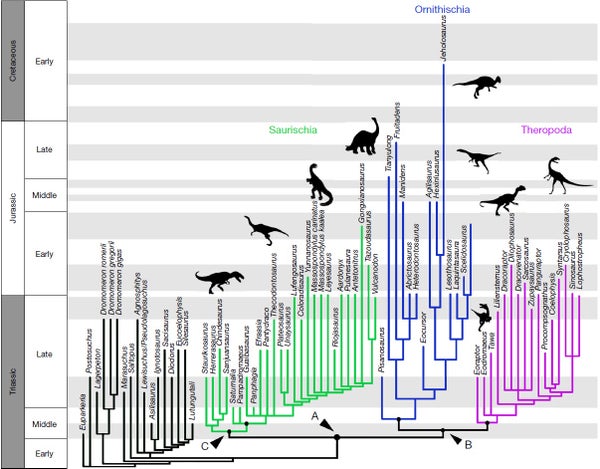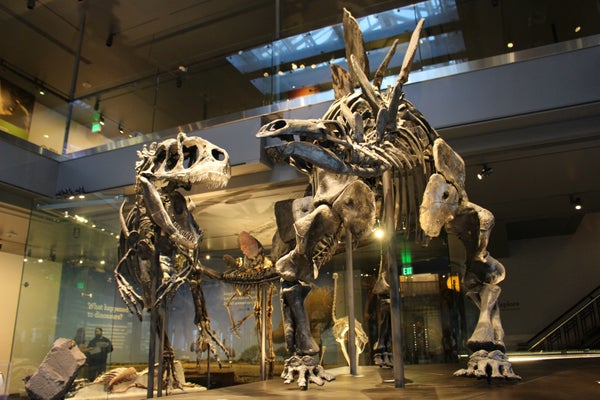This article was published in Scientific American’s former blog network and reflects the views of the author, not necessarily those of Scientific American
On November 24, 1887, naturalist Harry Govier Seeley stood before London’s Royal Society to make one of his most important contributions to paleontology. His paper was “On the Classification of the Fossil Animals commonly named Dinosauria” – the terrible lizards being exhumed in greater number and variety than anyone had anticipated.
The likes of Stegosaurus, Allosaurus, and Apatosaurus needed a new system to organize their ranks, Seeley argued. Other experts – such as Edward Drinker Cope and Othniel Charles Marsh from America, as well as Thomas Henry Huxley from England – had proposed their own classifications before, Seeley pointed out at the top of his lecture, but each system was flawed and there was no consensus among experts on which names would be used. So, to sort through the growing taxonomic tangle, Seeley proposed that the major groups of dinosaurs be separated from each other on the basis of their hips.
It was a simple and ingenious solution. The dinosaurs known at the time had the tripartite arrangements of their hip bones in one of two configurations. There were dinosaurs like Diplodocus and Ceratosaurus with a “lizard-hipped”, or saurischian, hip shapes immediately recognizable from a forward-pointing pubis bone. Other dinosaurs, such as Camptosaurus, had the pubis pointing backward to join another bone called the ischium in what Seeley called the ornithischian, or “bird-hipped” shape.
On supporting science journalism
If you're enjoying this article, consider supporting our award-winning journalism by subscribing. By purchasing a subscription you are helping to ensure the future of impactful stories about the discoveries and ideas shaping our world today.
Additional traits underscored the division. The saurischian dinosaurs included only theropods and sauropods, further united by pneumatic – or hollow – bones. The ornithischians, by contrast, included dinosaurs like Stegosaurus and Camptosaurus. And for 130 years, Seeley’s arrangement held fast.
There have been challenges and shake-ups over time – for example, when some paleontologists thought that the strange and varied ornithischians were more distantly related to other dinosaurs and deserved a separate grouping outside that famous name – and, admittedly, it’s a little confusing that “bird-hipped” dinosaurs don’t have anything to do with the ancestry of birds. Still, succeeding generations of paleontologists came to the consensus that Dinosauria is made up of the saurischian and ornithischian branches. The theropods and sauropods make up the saurischian side of the family tree, sharing a closer common ancestor with each other than the ornithischian dinosaurs that make up the other half of the famous family.
Now Seeley’s classic arrangement is in question. Earlier this year paleontologists Matthew Baron, David Norman, and Paul Barrett unveiled a new dinosaur phylogeny that offers very different view of who’s related to whom.
Baron and colleagues largely focused on protodinosaurs – technically called dinosauromorphs – and early dinosaurs from the Triassic to the early part of the Jurassic. This was the opening chapter of the Age of Reptiles, back when dinosaurs were starting to diversify but we’re really ruling the Earth yet. Recent discoveries in South America, Africa, and elsewhere have started to fill in details about this critical time like never before, and, Baron and coauthors argue, the characteristics of these archaic forms suggest some unexpected relationships.
After analyzing 457 skeletal characteristics in 74 taxa, Baron and coauthors concluded that theropods and sauropods are not each other’s closest relatives, after all. The new family tree more closely links the earliest ancestors of Tyrannosaurus (a theropod) and Triceratops (an ornithischian), with the long-necked sauropod dinosaurs out on a separate branch allied to an enigmatic group of early carnivorous dinosaurs called herrerasaurids. In this reshuffled nest of dinosaurian branches, then, theropods and ornithschians would belong to a group called the Ornithoscelida while sauropods and the herrerasaurids would be the new representatives of the Saurischia.

The new hypothesis of dinosaur relationships. Credit: Baron et al 2017
Formal responses to the paper have already started to trickle out. Thomas Holtz pointed out that a tweaked naming scheme might result in less confusing. For example, the existing name sauropodomorpha could be used to label all animals more closely related to Diplodocus than the theropods. Then again, the term Pachypodosauria could be used for these dinosaurs. "Such a scheme would accommodate the two competing hypotheses: a conventional Saurischia–Ornithischia split versus the new Pachypodosauria–Ornithoscelida division," Holtz wrote.
All of this taxonomic wrangling is about more than names. The new tree has major implications for what paleontologists think the earliest dinosaurs were like, not to mention how each of the major subdivisions evolved. If herrerasaurids only look like theropods, but are actually distant relatives, that means hypercarnivorous dinosaurs evolved at least twice near the root of the family tree. Likewise, the new arrangement might explain why some of the earliest-known ornithischian dinosaurs – such as Heterodontosaurus – have sharp, roughly theropod-like teeth and seem more omnivorous than their later descendants.
But is the new classification going to stick? Any phylogenetic tree is a hypothesis, subject to testing and change with additional analysis and discovery. Other experts may disagree about the species selected for analysis or how certain skeletal characteristics are coded in the input data. Likewise, the early record of ornithischian dinosaurs is so incredibly sparse that the discovery of any new skeleton could significantly change the results. Not to mention that the new analysis brings up the question of why theropods and sauropods share air sacs that lightened their skeletons and yet ornithischians – more closely allied to theropods in the new analysis – either never evolved or lost this trait.
There’s little to do right now except wait. Perhaps the new arrangement will gain traction, pushed along by additional evidence. Or maybe Seeley’s classification will be underscored as most representative of dinosaur relationships, after all. There’s even the possibility that some other, as-yet-unformulated classification will come out of this. But no matter how this discussion shakes out, the new study highlights how much we’re learning about the earliest dinosaurs and their forerunners.
The earliest days of the Triassic used to be known only from slivers and scraps. Now paleontologists are uncovering the story of how dinosaurs, and other forms of life, rapidly originated and diversified once the worst mass extinction of all time cleared the slate for the Age of Reptiles. Paleontologists may disagree over how these finds change dinosaur classification, but the growing wealth of fossil material that spurs these debates can only be a good thing.
References:
Baron, M., Norman, D., Barrett, P. 2017. A new hypothesis of dinosaur relationships and early dinosaur evolution. Nature. doi: 10.1038/nature21700
Holtz, T. 2017. Nomenclature: Share names for dinosaur divisions. Nature. doi: 10.1038/545030d
Seeley, H. 1887. On the classification of the fossil animals commonly named Dinosauria. Proceedings of the Royal Society of London. 43: 165-171
